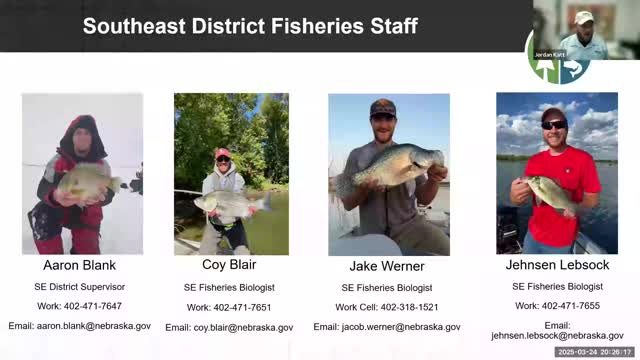Nebraska officials assess fish stocking trends and invasive carp threats
May 23, 2025 | Nebraska Game and Parks Commission (NGPC), State Agencies, Organizations, Executive, Nebraska
This article was created by AI summarizing key points discussed. AI makes mistakes, so for full details and context, please refer to the video of the full meeting. Please report any errors so we can fix them. Report an error »

The Nebraska Southeast District Fisheries Meeting held on May 23, 2025, focused on various topics related to local fisheries management and conservation efforts. Key discussions included the evaluation of fish stocking practices, the introduction of new species, and the ongoing challenges posed by invasive carp species.
One of the primary topics was the management of small sunfish populations in local waters. Officials announced plans to assess the effectiveness of current stocking strategies aimed at reducing the abundance of these fish. Additionally, the meeting highlighted the recent stocking of approximately 1,200 rainbow trout in Lake Calaca, with another stocking scheduled for December. Lake Calaca, known for its family-friendly fishing environment, also supports a healthy channel catfish population.
The meeting also addressed the potential expansion of smallmouth bass and yellow perch fisheries in the district. Officials noted that while trials at Big Elk and Portal lakes have shown success in producing these species, careful monitoring is necessary to manage natural recruitment and ensure the sustainability of these fisheries. The Trout Lake at 2 Rivers was mentioned as another site where these species are being evaluated, although growth rates have not matched those seen at the other lakes.
Concerns regarding invasive carp species, particularly silver and bighead carp, were also discussed. While no invasive carp have been found in local reservoirs, officials warned about their presence in nearby rivers and streams. They emphasized the importance of preventing the movement of fish between different water bodies to avoid introducing invasive species. Signage has been placed in areas where issues have previously arisen, reminding anglers to leave fish where they are caught.
As the meeting concluded, officials reiterated their commitment to ongoing evaluation and adaptation of fisheries management practices to ensure the health and sustainability of Nebraska's aquatic ecosystems.
One of the primary topics was the management of small sunfish populations in local waters. Officials announced plans to assess the effectiveness of current stocking strategies aimed at reducing the abundance of these fish. Additionally, the meeting highlighted the recent stocking of approximately 1,200 rainbow trout in Lake Calaca, with another stocking scheduled for December. Lake Calaca, known for its family-friendly fishing environment, also supports a healthy channel catfish population.
The meeting also addressed the potential expansion of smallmouth bass and yellow perch fisheries in the district. Officials noted that while trials at Big Elk and Portal lakes have shown success in producing these species, careful monitoring is necessary to manage natural recruitment and ensure the sustainability of these fisheries. The Trout Lake at 2 Rivers was mentioned as another site where these species are being evaluated, although growth rates have not matched those seen at the other lakes.
Concerns regarding invasive carp species, particularly silver and bighead carp, were also discussed. While no invasive carp have been found in local reservoirs, officials warned about their presence in nearby rivers and streams. They emphasized the importance of preventing the movement of fish between different water bodies to avoid introducing invasive species. Signage has been placed in areas where issues have previously arisen, reminding anglers to leave fish where they are caught.
As the meeting concluded, officials reiterated their commitment to ongoing evaluation and adaptation of fisheries management practices to ensure the health and sustainability of Nebraska's aquatic ecosystems.
View full meeting
This article is based on a recent meeting—watch the full video and explore the complete transcript for deeper insights into the discussion.
View full meeting
